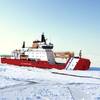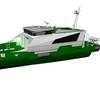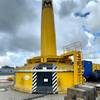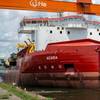In 1970, the U.S. Congress designated the Great Lakes region as the U.S.' fourth seacoast; which, while geographically inaccurate, is completely on target in terms of the importance of trade within that area. One of the most important waterways, the region is home to the U.S.-Flag Lakes fleet, perhaps the most vibrant segment of the U.S. Merchant Marine.
In terms of sheer numbers, the fleet is not large; with only approximately 70 large self-propelled vessels and tug/barge units in the dry- and liquid-bulk trades and another 20 smaller tug/barge units engaged in primarily moving liquid-bulk products.
However, in a typical shipping season, the U.S.-Flag Lakes fleet will haul upward of 115 million tons, or almost half a ton for every person living in the continental U.S., Alaska and Hawaii.
Almost all the vessels are "self-unloaders" - ships equipped so the crew can unload the vessel without any need for shoreside personnel or equipment. Some of the larger carriers (1,000 ft. long and larger) are capable of discharging as much as 70,000 tons of iron ore or coal in fewer than 10 hours.
The "Big Three" cargoes transported on the Lakes region, include iron ore for the steel industry, which averages nearly 60 million tons each shipping season, twice the total of the next largest commodities, stone or coal.
Limestone, which totals approximately 23 million tons, is the second largest cargo transported on the region. This steel industry uses "fluxstone" as a purifying agent in the steelmaking process. The construction industry uses "aggregate" as a base for highways, parking lots and sewer systems. The chemical and paper industries also use limestone. When all the applications for limestone are combined, it is estimated each American uses 8,000 lbs. per year.
The last main cargo transported is coal, with shipments totaling generally 20 million tons in a typical navigation season. The coal trade best exemplifies the benefits of intermodalism in the U.S. There is not a single large coal mine anywhere near a U.S. port on the Lakes. American railroads, normally a fierce competitor for cargo delivered by the lake fleet, actually delivers the coal to Lakes ports for final shipment by vessel to the customer.
Other cargo - namely cement, salt, grain, sand and various liquid-bulk products - makes up the remaining 10 percent.
The major concern facing operators on the Great Lakes this coming year, is the reintroducton of the Harbor Services User Fee (HSUF), to fund not only operation and maintenance (O&M) dredging of the nation's deepdraft ports and waterways, but also the Federal government's share of new dredging products. The 1998 edition of the proposal was so flawed that it was quickly rejected by industry and never submitted to Congress.
According to the Lake Carriers' Association, the impacts of the HSUF would be ruinous for Great Lakes shipping. The current Port Use Tax is based on the value of the cargo. So, with market values of roughly $30-35 per ton, iron ore and coal are taxed at a rate of four cents per ton. Under a complicated formula that taxes the vessel's "net registered tonnage" at the rate of 12 cents per ton, the tax would skyrocket to 24 cents per ton.
The scenario for limestone is even worse. With a value of only about six dollars per ton, limestone is currently taxed less than a penny per ton. Although the different sizes of vessels engaged in the stone trade make analysis difficult, early expectations are the new tax would range from 15 to 25 cents per ton, an amount the stone industry experts declare would exceed the profit margin on the commodity.
The following table estimates an average tax of 20 cents per ton and illustrates how the cost of Great Lakes shipping would increase for the three major commodities:
Of course, what would follow is obvious: Shippers with access to rail transportation would switch to that mode, but, locomotives burn significantly more fuel than vessels, and therefore produce more emissions. The environment would suffer from the almost endless stream of trains required (since it would take six 100-car unit trains to equal the hauling power of cargo in a 1,000-ft. vessel.).
Shippers without rail access would see the delivered cost of raw materials rise to the point where they would surely lose marketshare, perhaps even their economic viability.
In the 1970s, the Federal government built 26 Confined Disposal Facilities (CDF) to contain the sometimes polluted sediments dredged from the Great Lakes. Previously, Open Lake disposal of dredged material had been the common practice.
However, unfounded fears forced virtually all dredgings to be deposited in a CDF; not just the polluted sediments. As a result, the 26 sites are rapidly nearing capacity - in fact, it is anticipated all but two will be full by the year 2010.
The USACE's ability to maintain the Great Lakes system at a designed vessel draft of 25.5 ft. is crucial to the efficiency of waterborne transportation. A 1,000 ft. ship forfeits approximately 270 tons of cargo for each in. reduction in loaded draft. An ocean-going vessel sized to fit the St. Lawrence Seaway loses roughly 100 tons of cargo capacity for each lost in. of loaded draft.
Given stiff competition among transportation modes and port ranges, even a one-in. reduction in loaded draft is a disadvantage. However, the problem is more serious than that. The available depth in the entrance channel to Toledo, Ohio, has been reduced by as much as 18 in. by siltation. A 1,000-ft. vessel delivering iron ore to Toledo loses approximately 5,000 tons of cargo each time the ship calls on the port, due to the 18 in. of lost draft.
Dredging will finally resume in Indiana Harbor after more than 20 years. Ore boats feeding the area mills have surrendered as much as 16 in. of draft, or more than 4,300 tons of cargo on each arrival. Vessels serving the gypsum trade to Waukegan are "light loading" by as much as 2,500 tons each trip, because that port's inner harbor has not been dredged since 1969.
Besides the environmental concerns, construction of CDFs have been stalled by uncertainty over the Federal government's role in financing projects. The uncertainty was resolved though, with the passage of the Water Resources Development Act of 1996, which mandated the Federal government will fund CDFs at the same ratio as its contribution to the navigation project.
Sponsored Content
Safer Starts Here: Build Ships, Protect Crews

Featured videos

“One Man, One Wrench” Launched a Global Maritime Power Play

Cat Pushes Forward on Hybrid Electric Solutions, Alternative Fuels

Corn Belt Ports Streamlines Critical Agriculture River Shipments
Subscribe for
Maritime Reporter E-News
Maritime Reporter E-News is the maritime industry's largest circulation and most authoritative ENews Service, delivered to your Email five times per week









